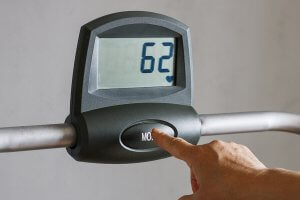Karvonen’s Formula to Calculate your Heart Rate

More and more people are using heart rate monitors during training. And with good reason! If you know how to use them, they can be a valuable tool. They help you to make the most out of the time you dedicate to physical activity and taking care of your health. If you know how to use it correctly, Karvonen’s formula can help you too.
The heart rate monitor helps us measure our maximum heart rate and resting heart rate. It also allows us to calculate an optimal heart rate to be able to resist a long workout.
However, it’s necessary to have some basic concepts to be able to use these devices correctly. Similarly, it’s essential to know your body well, so as to get the most out of them.
In short, Karnoven’s formula is a mathematical formula that helps you calculate the optimum heart rate you should maintain when training. In this article, we’ll explain what this formula entails.
What is the heart rate?
Heart rate is the number of times the heart contracts within a minute. This frequency varies from one person to another and changes throughout the day, depending on a large number of stimuli.
The heart rate can be measured by counting the number of pulses for 15 seconds and multiplying them by four. However, the most accurate way to do this is by means of a heart rate monitor.
The resting heart rate is the minimum heart rate a person has when they’re awake. It usually varies between 50 and 100 beats per minute, depending on each person. Those who train regularly and professional athletes have a lower resting heart rate.
To be able to measure your minimum heart rate correctly, it’s necessary to do it right after waking up, or after ten minutes of rest. It should always be measured on an empty stomach and without having done any intense physical activity before. To obtain a more precise measurement, it’s advisable to measure it for at least three days in a row to achieve an average reading.

On the other hand, the maximum heart rate is the maximum value at which a heart can beat. This figure is relative and varies from one person to another depending on various factors, such as age, heart size, room temperature, hydration, etc.
There are several ways to calculate the maximum heart rate, without any being totally accurate. However, one of the most popular formulas is to subtract your age from 220; the resulting number should be your maximum heart rate.
What is Karvonen’s formula?
Karvonen’s formula is a mathematical formula that’s used to calculate the target heart rate of each person according to the intensity of the activity they want to achieve based on their training goals. This might sound complicated, but it’s really simple.
This formula allows you to determine different ‘training zones’. This is something very useful for athletes as they can plan activities based on these areas.
This calculation combines the resting heart rate with the maximum heart rate and the training intensity that’s sought. In this way, it sets a goal heart rate.
Karvonen’s formula is as follows: % of target heart rate = (residual heart rate x % intensity) + resting heart rate. The difference between the maximum and resting heart rate is called the residual or reserve heart rate.
For example, let’s calculate the optimal heart rate for a training intensity of 80 percent. For this example, a person’s maximum heart rate is 200 and the minimum is 50. This way, the Karvonen’s formula goes like this: (150 x 0.8) + 50 = 170 ppm
This final value means that to train at 80 percent of your heart capacity, you should have a heart rate of 170 while training.
Workouts based on heart rate
Once you know the maximum and resting heart rate values, the Karvonen’s formula for each person can be calculated quite easily. Then, once you have your target heart rate value, you can design training plans on that value.

You can make the calculation for all the intensities that you want to reach and draw up a table with the corresponding heart rate. Experts distinguish five training zones based on intensity; each coach or athlete will analyze which of them should be placed.
These zones range from zone one, which implies between 50 and 60 percent intensity and corresponds to a zone of heating, rehabilitation, physical conditioning, etc. It then reaches up to zone five, with 90 to 100 percent intensity, which corresponds to the maximum effort we can endure.
More and more people are using heart rate monitors during training. And with good reason! If you know how to use them, they can be a valuable tool. They help you to make the most out of the time you dedicate to physical activity and taking care of your health. If you know how to use it correctly, Karvonen’s formula can help you too.
The heart rate monitor helps us measure our maximum heart rate and resting heart rate. It also allows us to calculate an optimal heart rate to be able to resist a long workout.
However, it’s necessary to have some basic concepts to be able to use these devices correctly. Similarly, it’s essential to know your body well, so as to get the most out of them.
In short, Karnoven’s formula is a mathematical formula that helps you calculate the optimum heart rate you should maintain when training. In this article, we’ll explain what this formula entails.
What is the heart rate?
Heart rate is the number of times the heart contracts within a minute. This frequency varies from one person to another and changes throughout the day, depending on a large number of stimuli.
The heart rate can be measured by counting the number of pulses for 15 seconds and multiplying them by four. However, the most accurate way to do this is by means of a heart rate monitor.
The resting heart rate is the minimum heart rate a person has when they’re awake. It usually varies between 50 and 100 beats per minute, depending on each person. Those who train regularly and professional athletes have a lower resting heart rate.
To be able to measure your minimum heart rate correctly, it’s necessary to do it right after waking up, or after ten minutes of rest. It should always be measured on an empty stomach and without having done any intense physical activity before. To obtain a more precise measurement, it’s advisable to measure it for at least three days in a row to achieve an average reading.

On the other hand, the maximum heart rate is the maximum value at which a heart can beat. This figure is relative and varies from one person to another depending on various factors, such as age, heart size, room temperature, hydration, etc.
There are several ways to calculate the maximum heart rate, without any being totally accurate. However, one of the most popular formulas is to subtract your age from 220; the resulting number should be your maximum heart rate.
What is Karvonen’s formula?
Karvonen’s formula is a mathematical formula that’s used to calculate the target heart rate of each person according to the intensity of the activity they want to achieve based on their training goals. This might sound complicated, but it’s really simple.
This formula allows you to determine different ‘training zones’. This is something very useful for athletes as they can plan activities based on these areas.
This calculation combines the resting heart rate with the maximum heart rate and the training intensity that’s sought. In this way, it sets a goal heart rate.
Karvonen’s formula is as follows: % of target heart rate = (residual heart rate x % intensity) + resting heart rate. The difference between the maximum and resting heart rate is called the residual or reserve heart rate.
For example, let’s calculate the optimal heart rate for a training intensity of 80 percent. For this example, a person’s maximum heart rate is 200 and the minimum is 50. This way, the Karvonen’s formula goes like this: (150 x 0.8) + 50 = 170 ppm
This final value means that to train at 80 percent of your heart capacity, you should have a heart rate of 170 while training.
Workouts based on heart rate
Once you know the maximum and resting heart rate values, the Karvonen’s formula for each person can be calculated quite easily. Then, once you have your target heart rate value, you can design training plans on that value.

You can make the calculation for all the intensities that you want to reach and draw up a table with the corresponding heart rate. Experts distinguish five training zones based on intensity; each coach or athlete will analyze which of them should be placed.
These zones range from zone one, which implies between 50 and 60 percent intensity and corresponds to a zone of heating, rehabilitation, physical conditioning, etc. It then reaches up to zone five, with 90 to 100 percent intensity, which corresponds to the maximum effort we can endure.
All cited sources were thoroughly reviewed by our team to ensure their quality, reliability, currency, and validity. The bibliography of this article was considered reliable and of academic or scientific accuracy.
- Club Atletisme Sant Joan. 2011. Fórmula de Karvonen. Extraído de: https://corredorespopulares.files.wordpress.com/2011/12/formula-de-karvonen.pdf
- Edgar Lopategui Corsino. 2011. Determinación de la intensidad del ejercicio mediante la frecuencia cardíaca. Extraído de: http://www.saludmed.com/PEjercicio/requisitos/laboratorios/Determinacion_Intensidad-FCE.pdf
This text is provided for informational purposes only and does not replace consultation with a professional. If in doubt, consult your specialist.








